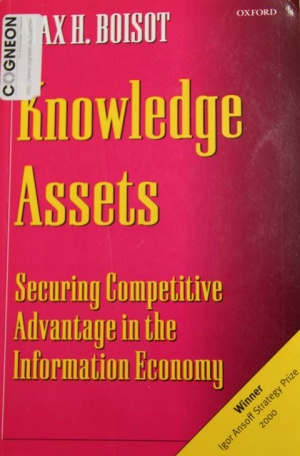Knowledge Assets: Securing Competitive Advantage in the Information Economy: Unterschied zwischen den Versionen
Aus Copedia
K.kley (Diskussion | Beiträge) Keine Bearbeitungszusammenfassung |
K.kley (Diskussion | Beiträge) Keine Bearbeitungszusammenfassung |
||
| Zeile 1: | Zeile 1: | ||
{{Piktogramm_buch}} | {{Piktogramm_buch}} | ||
[[Bild:Knowledge_Assets.jpg|thumb]] | |||
The effective management of knowledge assets is a key requirement for securing competitive advantage in the emerging information economy. The nature of knowledge assets, however, remains poorly understood. In this new paperback edition of '''Knowledge Assets: Securing Competitive Advantage in the Information Economy''', Max Boisot provides a conceptual framework for managers how knowledge and information assets differ from physical assets, and how to deal them at a strategic level within their organizations.<ref>Boisot, M.: Knowledge Assets: Securing Competitive Advantage in the Information Economy</ref> | The effective management of knowledge assets is a key requirement for securing competitive advantage in the emerging information economy. The nature of knowledge assets, however, remains poorly understood. In this new paperback edition of '''Knowledge Assets: Securing Competitive Advantage in the Information Economy''', Max Boisot provides a conceptual framework for managers how knowledge and information assets differ from physical assets, and how to deal them at a strategic level within their organizations.<ref>Boisot, M.: Knowledge Assets: Securing Competitive Advantage in the Information Economy</ref> | ||
Version vom 22. März 2013, 10:30 Uhr
The effective management of knowledge assets is a key requirement for securing competitive advantage in the emerging information economy. The nature of knowledge assets, however, remains poorly understood. In this new paperback edition of Knowledge Assets: Securing Competitive Advantage in the Information Economy, Max Boisot provides a conceptual framework for managers how knowledge and information assets differ from physical assets, and how to deal them at a strategic level within their organizations.[1]
Capters:
- Introduction
- The Information Perspective
- The Information Space (I-Space)
- The Paradox of Value
- Neoclassical versus Schumpeterian Orientation to Learning
- Culture as a Knowledge Asset
- Products, Technologies, and Organization in the Social Learning Cycle
- Competence and Intent
- Information Technology and its Impact
- Applying the I-Space
- Recapitulation and Conclusion
Einzelnachweise
- ↑ Boisot, M.: Knowledge Assets: Securing Competitive Advantage in the Information Economy
